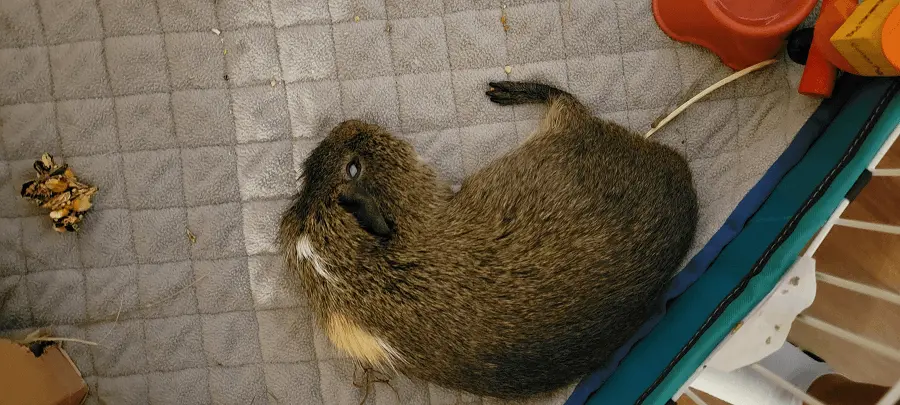Forget counting sheep! Discover the secret language of guinea pig sleep! Beyond the adorable sploots and loafs, each snoozing pose whispers clues about their well-being. Learn why they nap with one eye open. Discover what a belly sprawl reveals.
Find out how to create the perfect sleep haven for your furry friend. Dive into the fascinating world of guinea pig sleep. It is the key to understanding their hearts and keeping them thriving!
Sleep with One Eye Open: The Prey Animal Instinct
Have you ever caught your guinea pig napping with their eyes partially open? It might seem strange, but it’s a common behavior. This behavior is rooted in their evolutionary history as prey animals.
Here’s why they do it:
- Constant Vigilance: Guinea pigs sleep with one eye open to stay alert for potential predators, even in the safety of their homes. This instinct is crucial for survival in the wild, where danger can lurk around every corner.
- Shallow Sleep and Deep Dreams: While they might appear awake, guinea pigs can still rest and recharge during these open-eyed naps. They also experience deeper sleep phases throughout the day, closing their eyes completely and relaxing their muscles. This deeper sleep is a sign of trust in their environment and a testament to the bond they share with their caregivers.
Related Article: Guinea Pig Care Guide: Must-Knows for New Owners
Decoding the Sleepy Dictionary: A Guide to Guinea Pig Sleeping Positions
Guinea pigs show comfort and well-being through their sleeping positions. They have mystery in their eyes. Each pose offers a glimpse into their inner world. It can even reveal potential health concerns.
Here are a few common positions to decipher:
- Splooting Serenity
- Breadloaf Bliss
- Side Snoozing
- Cuddle Puddle Paradise
- Head Down for a Power Nap
Stay tuned for the next segment, where we’ll dive deeper into each position and explore their potential meanings!
Splooting Serenity: Unraveling the Contentment of the Belly Sprawl
Ah, the sploot – a guinea pig classic! This belly-down starfish pose is one of the most adorable and seemingly carefree sleep positions. But what does it really mean?
Unwinding Like a Pro:
- Ultimate relaxation: Splooting signifies total comfort and release of tension. Imagine sinking into a warm bath – that’s the splooting feeling for a guinea pig!
- Cooling off: Exposing their bellies helps regulate body temperature, especially important on hot days.
- Stretching it out: Splooting allows for a full-body stretch, keeping their muscles limber and ready for playtime.
Sploot Variations:
- Classic sprawl: All four limbs sprawled out to the sides, creating a perfect X shape. This is pure contentment personified!
- One-leg tuck: One hind leg tucked under the body for added coziness. Think of it as a half-sploot, still conveying relaxation but with a touch of snuggling in.
- Head tilt: A bonus level of cuteness! When they rest their head on the ground while splooting, it’s a sign of ultimate trust and security in their environment.
Breadloaf Bliss: Cozy Security in a Loaf-Like Form
The breadloaf position might just be the king of guinea pig cuteness. These compact, tucked-in bundles of fluff radiate an aura of pure comfort and security. Let’s unpack the meaning behind this irresistible snooze:
Cozy Like a Bakery Fresh Bun:
- Safe and sound: Curled up into a tight ball, your guinea pig minimizes exposed surfaces, creating a sense of protection and vulnerability reduction.
- Warmth preservation: Tucking their limbs close to their body conserves precious body heat, especially important during colder nights or drafts.
- Contentment and peace: The breadloaf position often indicates deep relaxation and a feeling of safety within their environment.
Breadloaf Variations:
- Full tuck: All four limbs tucked neatly under the body, forming a perfect loaf shape. This is peak breadloaf cuteness and signifies ultimate comfort and security.
- Head under chin: For an extra dose of snugness, some guinea pigs tuck their head under their chin, creating a cozy cocoon-like effect.
- Leggy loaf: Not all breadloaves are perfectly symmetrical! Some piggies might leave one or two legs outstretched, adding a touch of quirkiness to the classic pose.
Remember: While breadloafing is adorable, be mindful of potential red flags:
- Labored breathing: If your guinea pig struggles to breathe while in this position, it could indicate respiratory issues.
- Stiffness or unusual posture: Difficulty getting comfortable or unnatural contortions might point to pain or discomfort.
- Excessive wetness: As with other positions, drooling beyond normal sleep levels could be a sign of dental problems.
Side Snoozing: Sweet Dreams or Cause for Concern?
Lying on their side is a common sleeping position for guinea pigs, but interpreting its meaning requires a closer look.
Signs of Contentment:
- Relaxed limbs: When your guinea pig sleeps on their side with legs and paws outstretched, it usually indicates deep relaxation and contented sleep. Imagine a cat basking in the sun!
- Gentle breathing: Regular, shallow breaths accompany this sweet dream state.
- Short naps: If they only snooze for brief periods on their side, it’s likely just a comfortable position for a quick power nap.
Potential Health Concerns:
- Labored breathing: Difficulty breathing or wheezing while side-sleeping can be a sign of respiratory issues or other health problems. Consult a veterinarian if you notice this.
- Limpness or unusual posture: If your guinea pig appears unnaturally stiff or seems distressed while side-sleeping, it might indicate pain or discomfort. Monitor their behavior closely and seek veterinary advice if needed.
- Extended periods: While occasional side-sleeping is normal, if your guinea pig stays in this position for extended periods, it’s worth observing their overall behavior and environment. Ensure their cage is clean, comfortable, and not causing any pressure points.
Cuddle Puddle Paradise: The Language of Bonding and Warmth
Two or more guinea pigs piled together in a cozy heap? Welcome to the “cuddle puddle.” It’s a heart-melting sight. It reveals the strong social bonds and warmth-seeking nature of these furry friends.
A Sign of Togetherness:
- Shared comfort: Huddling close provides physical warmth and comfort, especially in colder environments.
- Social bonding: Cuddling is a way for guinea pigs to strengthen their social bonds and express affection towards each other. The shared scent and body heat foster a sense of security and belonging.
- Contentment and trust: Seeing your guinea pigs curled up together is a sign they feel happy, safe, and comfortable with each other.
Beyond the Cuteness:
- Space considerations: Ensure your cage is large enough for all guinea pigs to cuddle comfortably without feeling cramped.
- Individual preferences: Some guinea pigs are naturally cuddlier than others. Respect their individual personalities and let them choose how close they want to be.
- Monitor for dominance: While occasional squabbles over snuggle position are normal, observe for signs of bullying or aggressive behavior.
Head Down for a Power Nap: Seeking Peace and Quiet
Tucking their head down to touch the cage floor or resting it on an object like a hidey-hole signifies a specific kind of snooze for your guinea pig. It’s a power nap.
Seeking Tranquility:
- Short bursts of sleep: Head-down naps are typically brief, lasting for a few minutes to an hour. They’re perfect for a quick energy boost in the middle of the day.
- Seeking peace and quiet: This posture often indicates a desire for a calm environment away from noise or bright light. Provide your guinea pig with quiet hideaways or shaded resting spots if they tend to nap this way.
- Sensitivity to light: If your guinea pig frequently sleeps with their head down during the day, consider if their environment might be too brightly lit. Adjusting the placement of their cage or adding curtains can help regulate light exposure.
More Than Just Napping:
- Discomfort or illness: While occasional head-down naps are normal, prolonged periods or changes in usual sleeping patterns can be a sign of illness or discomfort. Observe your guinea pig for other symptoms like lethargy, loss of appetite, or difficulty breathing. If needed, consult a veterinarian.
- Consider the context: Remember, interpreting sleeping positions should be done holistically. Observe your guinea pig’s overall behavior and environment for a complete picture of their well-being.
Building the Perfect Snooze Zone: Tips for Optimal Sleep Health
Now that you’re a guinea pig sleep decoder extraordinaire, let’s focus on creating the ideal environment for their precious slumber. Here are some key tips to ensure those adorable sleepy poses translate into happy and healthy piggies:
Cleanliness Counts:
- Regular cage cleaning: A hygienic cage free from droppings and stale hay is crucial for respiratory health and overall well-being. Aim for daily spot cleaning and a full cage clean at least once a week.
- Cozy bedding: Provide ample comfy bedding like fleece or shredded paper for them to burrow into and snuggle up for warmth. Clean and replace the bedding regularly.
Comfort is Key:
- Spacious slumber zone: Ensure your cage is large enough for each guinea pig to have their own space for sleeping and playing. Overcrowding can lead to stress and sleep disturbances.
- Variety is the spice of sleep: Offer different sleeping options like hammocks, hides, and tunnels. This caters to individual preferences and provides a sense of security.
- Temperature control: Guinea pigs prefer cooler temperatures around 65-75°F. Avoid placing their cage in drafty areas or direct sunlight.
Sweet Dreams on a Quiet Tune:
- Minimal noise disruptions: Place their cage away from loud sounds like TVs or children’s play areas. Sudden noises can startle them and disrupt sleep.
- Gentle light exposure: Avoid bright lights near their sleeping areas, especially during nighttimes. Dim lighting or curtains can help them sleep soundly.
- Routine matters: Maintain a consistent sleep schedule with minimal disruptions during their usual snooze times.
Bonus Tips for Sleepy Success
- Exercise for better sleep: Encourage playtime and exercise outside the cage. This helps them tire out and sleep more soundly.
- Monitor sleep patterns: Keep an eye on their overall sleep habits and consult a vet if you notice any significant changes or persistent concerns.
- Cuddle time after lights out: Bonding cuddles before bedtime can promote relaxation and strengthen your bond with your furry friend.
By following these tips, you can create a sleep haven for your guinea pigs. It caters to their natural instincts and needs. Remember, a good night’s sleep is essential for their physical and mental well-being. Understanding their sleepy language allows you to provide the best care possible.

